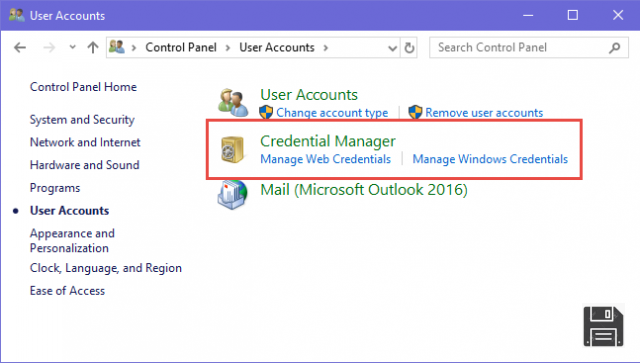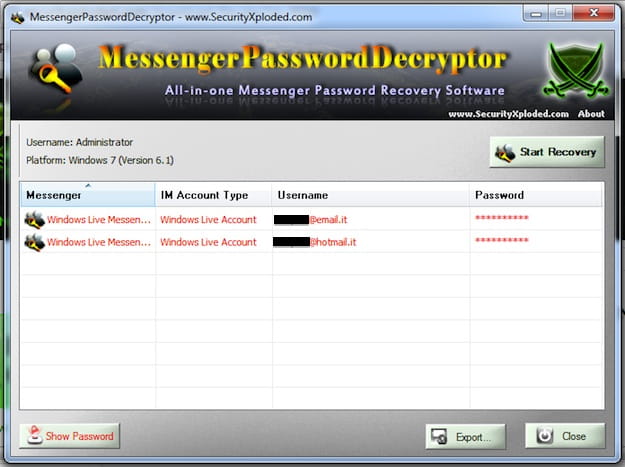You're lazy as usual. So that you don't have to remember them all from memory, you have set your browser to store the passwords for all your favourite websites. Okay, it's not exactly the height of privacy or security, but I can understand you. But, excuse me for sticking my finger in the wound, have you ever considered the possibility that due to a virus, a computer hardware problem or some other unlucky event you might lose access to all your passwords? No? Well, I'm afraid you should.
In fact, you know what? Since prevention is always better than cure, I suggest you don't waste any more time and find out how to recover passwords saved in Internet Explorer, Firefox and Chrome thanks to the instructions I'm about to give you. I assure you that it is a very simple operation and takes very little time. Moreover, the steps to be taken are the same regardless of the operating system used: Windows, macOS or Linux. Then we will also take care of Android and iOS for the mobile sector, but I don't want to anticipate you too much.
Now make yourself comfortable, take five minutes of free time and find out how to view the passwords stored in your favorite browser so that you can write them down in a safe place or, even better, organize them in a software suitable for the purpose, a password manager, which I will tell you about in the final part of the tutorial. Enjoy reading and have fun!
Retrieve passwords saved in Internet Explorer
If you still use Internet Explorer as your default browser (bad! It's an outdated browser!), you can view the passwords stored on your computer by clicking on the Start button (the flag icon located in the lower left corner of the screen), looking for the Control Panel in the menu that opens and selecting the Control Panel icon from the search results. If you are using a version of Windows later than Windows 7, be sure to choose the classic Control Panel, the one with the blue icon, and not the panel called "Settings", which instead refers to the modern-style Control Panel introduced in Windows 8.
In the window that opens, click on the search field at the top right, search for the term password and select the Manage Credentials icon from the search results.

You should now be in front of a window through which you can view Web credentials, i.e. passwords stored in Internet Explorer, and Windows credentials, i.e. access data for applications and system services.
To find out the password for a website stored in Internet Explorer, click on its name, select the Show option next to Password, type the password you use to access Windows and you're done.

If you want, from the same screen, by clicking on the name of a site and then the Remove item, you can remove the password from Internet Explorer's memory.
Retrieve saved passwords in Firefox
If you are using Firefox and want to view the saved passwords on your PC, click the ≡ button on the top right corner of the browser window and select the Options or Preferences item from the menu that opens.
Next, select the Security item from the left sidebar, click on the Saved Logins button and locate the site for which you wish to view the password.
Then click on the address of the site you are interested in, press the Show password button at the bottom right and answer Yes to the request that appears on the screen. You will see the username and password of the selected site next to its address.
From the same menu you can also delete a password stored in Firefox by selecting it and pressing the Remove button on the bottom left, and import passwords and other data from browsers such as Edge, Chrome and Internet Explorer by clicking the Import button on the bottom left and following the simple wizard.
I also inform you that by activating the Sync function from the ≡ menu and creating a Mozilla account (or accessing a Mozilla account you have already created previously), you can synchronize passwords and all other Firefox navigation data on all your devices connected to the same account.
On smartphones and tablets
If you are using Firefox on an Android device, you can view the list of login credentials stored in your browser by pressing the (...) button at the top right of the screen and going to Settings. Then go to Privacy and select Access Management from the menu that opens.
If you use an iPhone or iPad, you can access the same menu by pressing the ≡ button, selecting the Settings icon from the menu that appears and going to Accessi.
Retrieve saved passwords in Chrome
Chrome is one of the most used browsers in the world, and of course it also includes a function for saving passwords. If you use Chrome and want to find out which passwords are stored in the program's memory, click on the button (...) in the top right corner and select the menu setting item that opens.
Then, scroll down the page that opened up to the bottom and click on the Show advanced settings item to see Chrome's advanced settings. Then locate the section on Passwords and forms and click on Manage passwords to see the list of passwords stored in your browser.
Now you can view and manage the passwords stored in Chrome. To be more precise, to display in clear user name and password needed to access a site, you have to click on its address and then on the Show button that appears on the right.
Acting in the same way, but by clicking on the "x" instead of the "Show" button, you can delete the password stored by Chrome.
As you surely know (and as I explained in my tutorial on how to store passwords on Google Chrome), by associating Chrome to a Google account, you can store your passwords online on the Google Smart Lock password service and you can synchronize them on all your devices.
To view (and manage) the passwords stored online on Google Smart Lock, connect to this web page, log in to your Google account and click on the eye icon located next to a site address to view the password or on the "x" to delete it from Smart Lock.
On smartphones and tablets
Chrome is also available for Android and iOS, where you can save your passwords and sync them with other devices connected to the same Google account, but unfortunately it doesn't allow you to view them in plain text.
To view the sites for which Chrome stores passwords, tap the (...) button at the top right and select Settings from the menu that appears. Then go to Save Password and the screen that opens will show you the list of logins saved in Chrome.
To view passwords in clear text you can go to Google Smart Lock for password mentioned above (provided you have Chrome synchronized with your Google account and online password saving enabled).
Program to recover passwords from Internet Explorer, Firefox and Chrome
Don't you want to browse through Internet Explorer, Firefox and Chrome settings? No problem. If you use a Windows PC, you can download WebBrowserPassView: a free program that scans passwords stored in Internet Explorer (versions 4.0 - 11.0), Firefox, Chrome and Opera and displays them in plain text. It does not require installation to work and also allows you to export access data to Internet sites as a text file or HTML page.
To download WebBrowserPassView to your PC, connect to its official website, scroll down to the bottom of the page and click on Download WebBrowserPassView (In zip file). Then open the zip package containing the program, extract the contents into any folder and launch the WebBrowserPassView.exe executable.

A window will open with the passwords stored in all the browsers installed on your PC (among those supported by the program). To export all passwords to a text file, press the key combination Ctrl+A on the PC keyboard (to select them all, otherwise select them individually by Ctrl+click on them) and click on the floppy disk icon located in the upper left corner.
If you want to save your passwords as HTML files, go to View > HTML Report - All Items and save the web page that opens using the appropriate function of your default browser.
Note: Some antivirus engines may recognize WebBrowserPassView as a potential threat. This is because the program scans passwords stored in browsers, just as some malware does. This is actually a false positive, the software is reasonably safe, but to completely eliminate the risks, it is better to follow the "manual" password recovery procedure I explained earlier (this applies to WebBrowserPassView as well as to any other program of this kind).
Programs to manage passwords
As we have just seen together, recovering passwords saved in Internet Explorer, Firefox and Chrome is very simple. Just have physical access to the computer and you do everything in two clicks. That's why I recommend that you don't rely entirely on the password storage feature included in your browser, but use a password manager.

In case you have never heard of them, password managers are software that allows you to store passwords, credit card numbers and other important data in password-protected digital safes. This means that you only need to remember one password (called master password) to have access to all your passwords, which can then be long and complex just as the most basic security rules dictate. Another important thing to underline is that password managers integrate with all the most important browsers, allowing you to automatically fill in login forms and save the access data of all websites. In addition, they can synchronize data not only between multiple browsers, but also between multiple operating systems and devices (computers, smartphones and tablets).
There are password managers for all tastes and all needs, some are also free. If you want to know more, consult my post on how to manage passwords and choose the one that seems most convenient for your needs.






